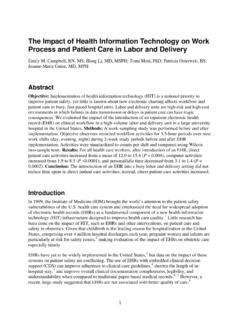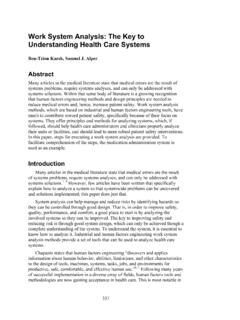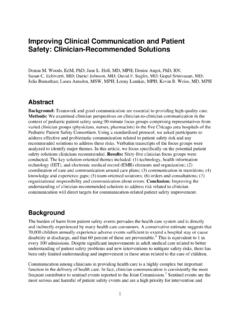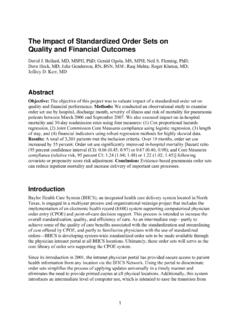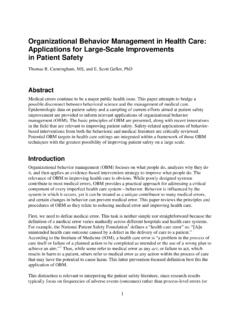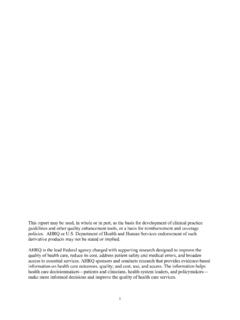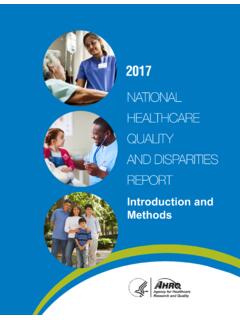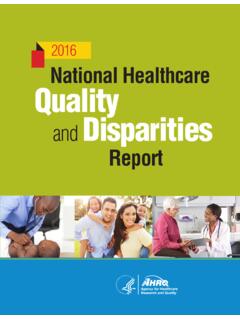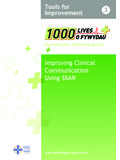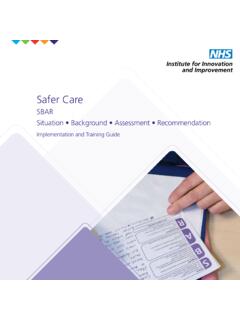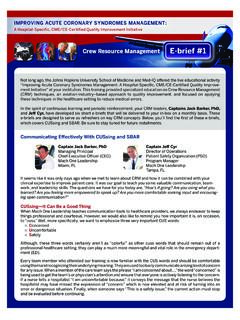Transcription of Pocket Guide: TeamSTEPPS: Strategies & Tools to Enhance ...
1 Pocket GuideTeam Strategies & Tools to Enhance Performance and Patient Safety2 Table of ContentsTeamSTEPPS Framework and Competencies ..4 Key Principles ..5 Team Structure Multi-Team System For Patient Care ..7 Communication SBAR ..9 Call-Out ..10 Check-Back ..11 Handoff ..12 I PASS THE BATON ..13 Leadership Effective Team Leaders ..15 Team Events ..16 Brief Checklist ..17 Debrief Checklist ..183 Table of ContentsSituation Monitoring situation Monitoring Process ..20 STEP ..21 Cross-Monitoring ..23 I M SAFE Checklist ..24 Mutual Support Task Assistance ..26 Feedback ..27 Advocacy and Assertion ..28 Two-Challenge Rule ..29 CUS ..30 DESC Script ..31 Team Performance Observation Tool.
2 32 Barriers, Tools and Strategies , and Outcomes ..33 Contact Information ..354 Framework and CompetenciesTeam Competency OutcomesKnowledge Shared Mental ModelAttitudes Mutual Trust Team OrientationPerformance Adaptability Accuracy Productivity Efficiency SafetyTeamSTEPPS has five key principles. It is based on team structure and four teachable-learnable skills: Communication, Leadership, situation Monitoring, and Mutual Support. The arrows depict a two-way dynamic interplay between the four skills and the team-related outcomes. Interaction between the outcomes and skills is the basis of a team striving to deliver safe, quality care and support quality improvement.
3 Encircling the four skills is the team structure of the patient care team, which represents not only the patient and direct caregivers, but also those who play a supportive role within the health care delivery is an evidence-based framework to optimize team performance across the health care delivery PrinciplesTeam Structure Identification of the components of a multi-team system that must work together effectively to ensure patient safetyCommunication Structured process by which information is clearly and accurately exchanged among team membersLeadership Ability to maximize the activities of team members by ensuring that team actions are understood, changes in information are shared, and team members have the necessary resourcesSituation Monitoring Process of actively scanning and assessing situational elements to gain information or understanding.
4 Or to maintain awareness to support team functioningMutual Support Ability to anticipate and support team members needs through accurate knowledge about their responsibilities and workloadTeam Structure7 Team StructureMulti-Team System For Patient CareSafe and efficient care involves the coordinated activities of a multi-team COORDINATING TEAM ANCILLARY& SUPPORTSERVICESCORE TEAM CONTINGENCY TEAMS PATIENT MTS Communication9 CommunicationSBARA technique for communicating critical information that requires immediate attention and action concerning a patient s conditionSituation What is going on with the patient? I am calling about Mrs. Joseph in room 251. Chief complaint is shortness of breath of new onset.
5 background What is the clinical background or context? Patient is a 62-year-old female post-op day one from abdominal surgery. No prior history of cardiac or lung disease. Assessment What do I think the problem is? Breath sounds are decreased on the right side with acknowledgment of pain. Would like to rule out pneumothorax. Recommendation and Request What would I do to correct it? I feel strongly the patient should be assessed now. Can you come to room 251 now? 10 CommunicationCall-OutStrategy used to communicate important or critical information Informs all team members simultaneously during emergent situations Helps team members anticipate next steps Important to direct responsibility to a specific individual responsible for carrying out the taskExample during an incoming trauma:Leader: Airway status?
6 Resident: Airway clear Leader: Breath sounds? Resident: Breath sounds decreased on right Leader: Blood pressure? Nurse: BP is 96/62 11 CommunicationCheck-BackUsing closed-loop communication to ensure that information conveyed by the sender is understood by the receiver as intendedThe steps include the following:1. Sender initiates the message2. Receiver accepts the message and provides feedback3. Sender double-checks to ensure that the message was receivedExample:Doctor: Give 25 mg Benadryl IV push Nurse: 25 mg Benadryl IV push Doctor: That s correct 1212 CommunicationHandoffThe transfer of information (along with authority and responsibility) during transitions in care across the continuum.
7 It includes an opportunity to ask questions, clarify, and of transitions in care include shift changes; transfer of responsibility between and among nursing assistants, nurses, nurse practitioners, physician assistants, and physicians; and patient designed to Enhance information exchange during transitions in care I PASS THE BATON IIntroductionIntroduce yourself and your role/job (include patient)PPatientName, identifiers, age, sex, locationAAssessmentPresent chief complaint, vital signs, symptoms, and diagnosesSSituationCurrent status/circumstances, including code status, level of (un)certainty, recent changes, and response to treatmentSSafety ConcernsCritical lab values/reports, socioeconomic factors, allergies, and alerts (falls, isolation, etc.)
8 THEBB ackgroundComorbidities, previous episodes, current medications, and family historyAActionsExplain what actions were taken or are required. Provide of urgency and explicit timing and prioritization of actionsOOwnershipIdentify who is responsible (person/team), including patient/family membersNNextWhat will happen next? Anticipated changes? What is the plan? Are there contingency plans?Leadership15 LeadershipEffective Team LeadersThe following are responsibilities of effective team leaders: Organize the team Identify and articulate clear goals ( , the plan) Assign tasks and responsibilities Monitor and modify the plan; communicate changes Review the team s performance.
9 Provide feedback when needed Manage and allocate resources Facilitate information sharing Encourage team members to assist one another Facilitate conflict resolution in a learning environment Model effective teamwork1616 LeadershipTeam EventsSharing the Plan Brief - Short session prior to start to share the plan, discuss team formation, assign roles and responsibilities, establish expectations and climate, anticipate outcomes and likely contingenciesMonitoring and Modifying the Plan Huddle - Ad hoc meeting to re-establish situational awareness, reinforce plans already in place, and assess the need to adjust the planReviewing the Team s Performance Debrief - Informal information exchange session designed to improve team performance and effectiveness through lessons learned and reinforcement of positive behaviors17 LeadershipBrief ChecklistDuring the brief, the team should address the following questions: Who is on the team?
10 Do all members understand and agree upon goals? Are roles and responsibilities understood? What is our plan of care? What is staff and provider s availability throughout the shift? How is workload shared among team members? What resources are available? 1818 LeadershipDebrief ChecklistThe team should address the following questions during a debrief: Was communication clear? Were roles and responsibilities understood? Was situation awareness maintained? Was workload distribution equitable? Was task assistance requested or offered? Were errors made or avoided? Were resources available? What went well? What should improve? situation Monitoring2020 situation MonitoringSituation Monitoring ProcessSituation monitoring is the process of continually scanning and assessing a situation to gain and maintain an understanding of what s going on around awareness is the state of knowing what s going on around you.

